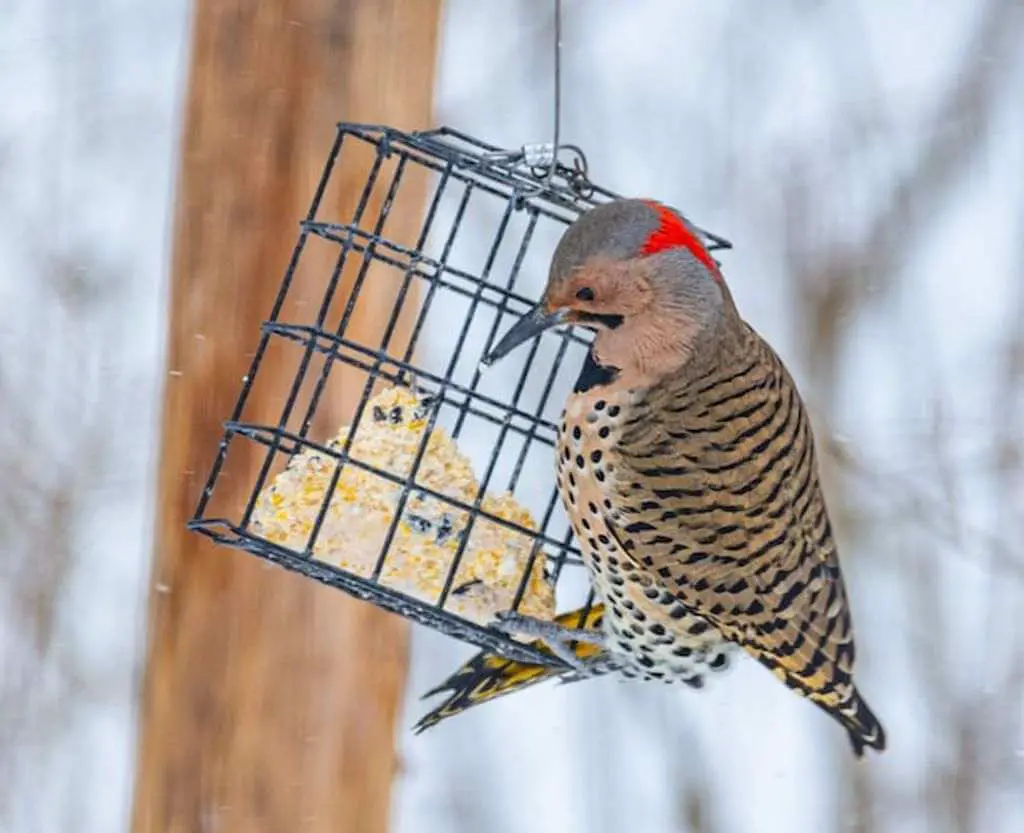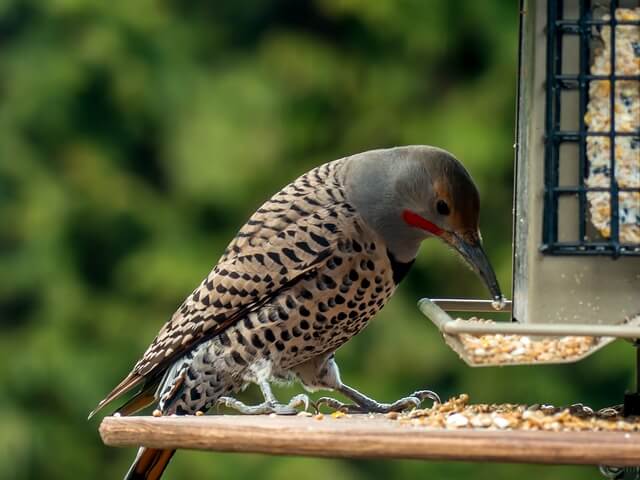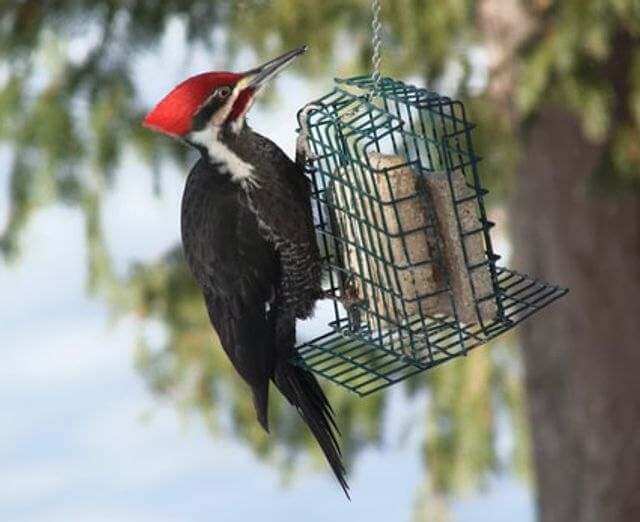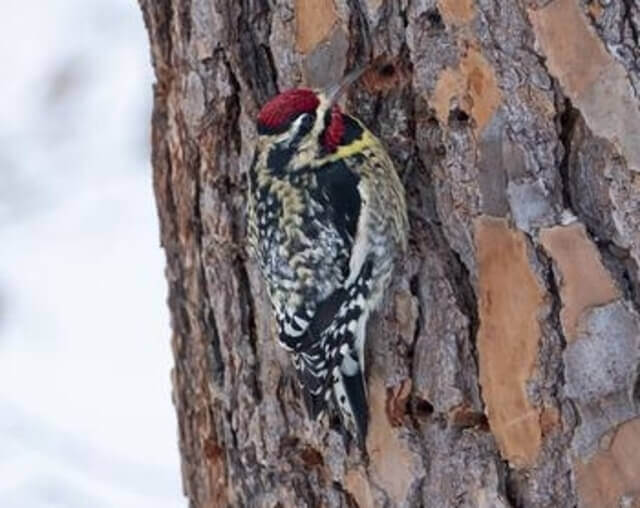Welcome to our comprehensive guide on the 8 types of woodpeckers found in Missouri! Woodpeckers are fascinating birds known for their drumming and pecking behaviors.
In this ultimate guide, we’ll explore the various species of woodpeckers native to Missouri, their unique characteristics, habitats, and behaviors.
Whether you’re a birdwatcher, nature enthusiast, or simply curious about Missouri’s wildlife, this guide is your go-to resource for learning all about these remarkable birds.
Types of Woodpeckers in Missouri
Red-bellied Woodpecker
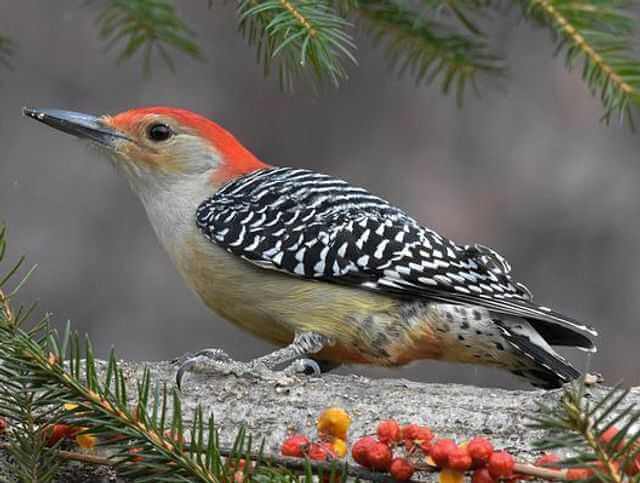
- Length: 9.5 in (24 cm)
- Weight: 2.0-3.2 oz. (56-90 g)
- Wingspan: 13.0-16.5 in (33-42 cm)
- Scientific Name: Melanerpes carolinus
- Frequency of Occurrence: 42.75% (Statistic by: eBird)
- Where To Find Them: The red-bellied woodpecker can be found in many parts of Missouri, but some of the more common locations are as follows: north and central parts of the state, around St. Louis; eastern parts of the state, around Kansas City; and southeastern parts of the state, around Springfield.
- How to Attract: Plant trees that provide food and nesting opportunities for this bird, such as the Virginia Pine or the White Oak. Hang bird feeders near areas where you see woodpeckers working, like near large trees. Make your yard more natural by planting native plants and grasses, and avoiding artificial colors and materials. Keep shrubbery trimmed so that it does not provide cover for birds in their nests, and make sure there is no litter on the ground that could attract woodpeckers. Be creative! There are many ways to create beautiful landscapes that also attract these birds, so get creative!
Description: The red-bellied woodpecker is a common bird found throughout most of North America. This woodpecker has a distribution that ranges from southern Canada and the lower 48 states, all the way down to Tierra del Fuego in Argentina. The red-bellied woodpecker primarily inhabits deciduous and mixed forests, but will also reside in coniferous forests.
The diet consists largely of insects, but the bird will also consume tree sap, small vertebrates, such as frogs, small fish, birds eggs, and seeds and nuts. The red-bellied woodpecker typically nests in tree cavities or on elevated platforms.
Related Post: How to Attract Red-bellied Woodpeckers to your Yard?
Downy Woodpecker
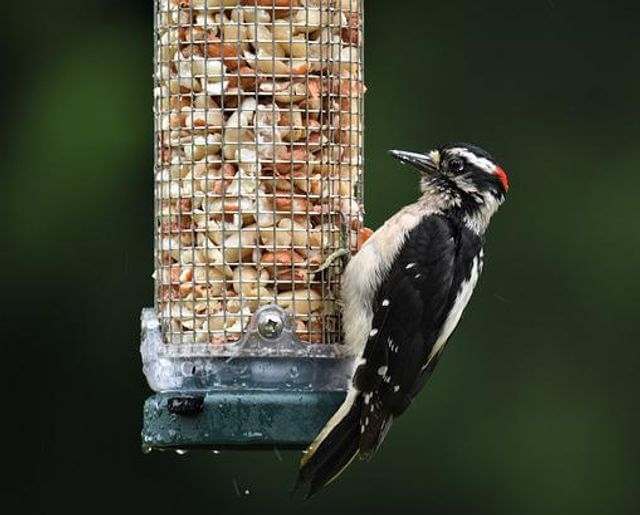
- Length: 5.5-6.7 in (14-17 cm)
- Weight: 0.7-1.0 oz. (21-28 g)
- Wingspan: 9.8-11.8 in (25-30 cm)
- Scientific Name: Picoides pubescens
- Frequency of Occurrence: 39.47%
- Where To Find Them: Downy Woodpecker are a common sight in Missouri, but there are a few locations where they can be found. These birds can often be seen in areas with lots of trees, such as the Bootheel and the Eastern Slope.
- How to Attract: If you’re looking to attract the Downy Woodpecker to your yard, one way to do so is by feeding them black-oil sunflower seeds. These birds are attracted to areas with plenty of trees and greenery, so planting a tree in your yard and topping it off with some suet should do the trick. Additionally, adding some fresh leaves and flowers to your yard can also help draw these birds in.
Description: The Downy Woodpecker is a small woodpecker that can be found throughout most of North America. It is the most common species of woodpecker in the eastern United States, and it is also found in parts of Canada. The Downy Woodpecker has a distribution range that extends from southern Canada to Central America, and from the Gulf of Mexico to Panama.
This bird prefers forests with plenty of trees, but it will also inhabit open areas if necessary. The Downy Woodpecker eats insects and other small animals that it finds in the trees. It usually nests in tree cavities, but sometimes it will build a platform on a branch.
Related Post: How to Attract Downy Woodpeckers to Your Yard? (Easy!)
Northern Flicker
- Length: 11.0-12.0 in (28-31 cm)
- Weight: 3.9-5.6 oz. (110-160 g)
- Wingspan: 16.5-20.0 in (42-51 cm)
- Scientific Name: Colaptes auratus
- Frequency of Occurrence: 20.34%
- Where To Find Them: The Northern Flicker is a common bird in Missouri. They can be found in many locations around the state, including parts of the Bootheel and the Ozarks.
- How To Attract: Northern Flickers prefer to live in trees, so it is important to choose the right tree type for them. Some of the best tree types for Northern Flickers include black-oil sunflower seeds and suet cakes. Another way to attract Northern Flickers to your yard is by providing them with a nest box. This will allow them to raise their young and stay close to home.
Description: The Northern Flicker is a widespread bird found in the eastern and central United States. The range includes the east coast from New Jersey to Florida, the Appalachian Mountains, and the Great Lakes region. They are also found in southern Canada.
The Northern Flicker is primarily a woodland bird, but can be found near open areas if they have enough trees. They are omnivorous but mainly eat insects, spiders, and other small creatures, fruits and seeds. They build their nests in small tree cavities or on poles.
Related Post: How to Attract Northern Flickers to your Backyard (Easy)
Pileated Woodpecker
- Length: 15.8-19.3 in (40-49 cm)
- Weight: 8.8-12.3 oz. (250-350 g)
- Wingspan: 26.0-29.5 in (66-75 cm)
- Scientific Name: Dryocopus pileatus
- Frequency of Occurrence: 11.03%
- Where To Find Them: There are currently two locations where you can see this bird in the state – Fort Leonard Wood and Cape Girardeau.
- How To Attract: The best way to attract a pileated woodpecker to your backyard is by providing them with adequate food and shelter. Be sure to provide plenty of trees and branches for them to perch on, as well as plentiful fruit and insects. You can also set out some bird feeders in your yard with black-oil sunflower seeds, or build a special bird house for them.
Description: The pileated woodpecker is the largest woodpecker that can be found in both North America. The pileated woodpecker’s distribution range includes most of North America, as well as sections of Central America and South America. The pileated woodpecker inhabits mainly deciduous and mixed forest, but has also been observed in coniferous forests.
The diet of the pileated woodpecker consists mainly of insects, but it will also eat fruits and nuts. Pileated woodpeckers typically build their nests in trees, but they have been known to nest on the ground.The Pileated Woodpecker nests in tree cavities. Nests are usually composed of tree branches and leaves, and sometimes include moss or lichen.
Related Post: How to Attract Pileated Woodpeckers to your Yard (Fast)
Hairy Woodpecker
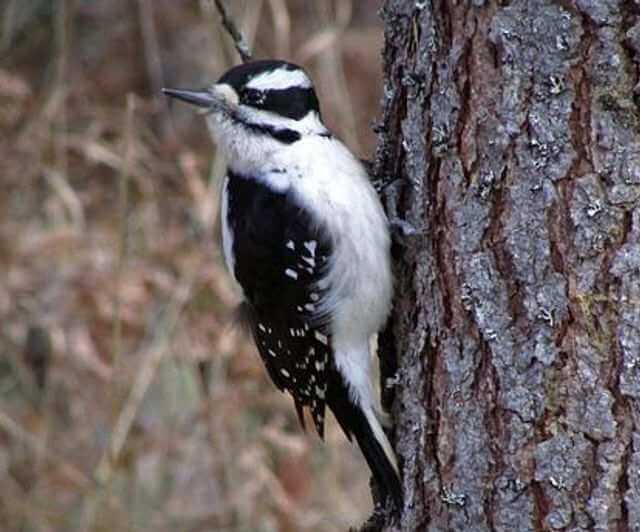
- Length: 7.1-10.2 in (18-26 cm)
- Weight: 1.4-3.4 oz. (40-95 g)
- Wingspan: 13.0-16.1 in (33-41 cm)
- Scientific Name: Picoides villosus
- Frequency of Occurrence: 9.92%
- Where To Find Them: The Hairy Woodpecker can be found in a variety of locations in Missouri. Some of the places where they can be seen include areas near St. Louis, Kansas City, and Springfield.
- How To Attract: Plant trees that provide the bird with plenty of nesting spots, like the American beech or the white oak. Other favorites include apple, cherry, pear and maple trees. Hang bird feeders high up in trees, especially if you have locations that are particularly favorable for woodpeckers such as near power lines or other tall structures.
Description: The Hairy Woodpecker is a common bird in the United States and Canada. It is found in all but the coldest parts of North America. The Hairy Woodpecker’s distribution range extends from southern Quebec to central California and east to Oklahoma, Texas, and Georgia. The habitat of the Hairy Woodpecker ranges from broad-leaf forests to oak-covered hillsides.
The diet of the Hairy Woodpecker includes insects, spiders, beetles and other small animals but also fruits, berries, and nuts, as well as tree sap. The Hairy Woodpecker nests in tree cavities, constructing a platform of sticks and feathers.
Red-headed Woodpecker
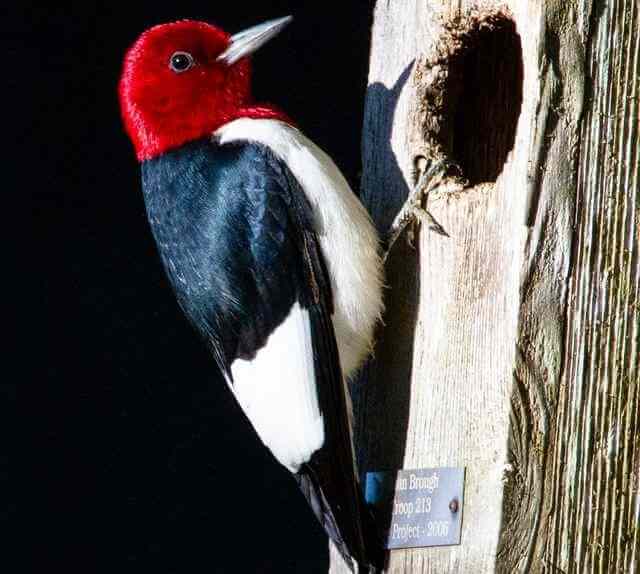
- Length: 7.5-9.1 in (19-23 cm)
- Weight: 2.0-3.2 oz. (56-91 g)
- Wingspan: 16.5 in (42 cm)
- Scientific Name: Melanerpes erythrocephalus
- Frequency of Occurrence: 9.64%
- Where To Find Them: The red-headed woodpecker is a bird that can be found in many locations throughout Missouri. They can often be seen in areas with trees and some type of overhead structure, such as a treehouse or tower. The red-headed woodpecker is a common sight in the St. Louis area and is also commonly seen in Kansas City, Columbia, and Springfield.
- How to Attract: Feed them black oil sunflower seeds – these birds love these crunchy snacks and will come to your feeder for them regularly. Make a nesting box for them – this will help the woodpecker to raise its young in safety and comfort. Put up some bird baths – these tempting water sources will lure the woodpeckers in droves. Decorate your yard with brightly colored flowers – redheads love brightly colored blooms!
Description: The Red-headed Woodpecker is a common bird in the northeastern United States. It is also found throughout most of Canada and parts of Mexico. The Red-headed Woodpecker ranges from southern New England, through the Middle Atlantic states, to Texas and Louisiana. It inhabits deciduous and mixed forests, as well as orchards, but is more commonly seen near streams and ponds.
The diet of the Red-headed Woodpecker consists mainly of insects, but it will also eat fruits, nuts and seeds. The red-headed woodpecker nests in tree cavities, typically choosing a cavity that’s already been used by another bird.
Related Post: Interesting Red-Headed Woodpecker Facts (Explained)
Yellow-bellied Sapsucker
- Length: 7.1-8.7 in (18-22 cm)
- Weight: 1.5-1.9 oz. (43-55 g)
- Wingspan: 13.4-15.8 in (34-40 cm)
- Scientific Name: Sphyrapicus varius
- Frequency of Occurrence: 3.51%
- Where To Find Them: This beautiful creature can be found in many locations throughout the state, but some of the best places to see them are at Lewis and Clark State Park, De Soto National Forest, and Table Rock Lake.
- How to Attract: Place a feeder filled with mealworms or suet near the bird bath or pond where you want them to frequent. Keep the feeder clean and full so the birds know it’s always there for them.
Description: The yellow-bellied sapsucker is a common bird in North America. The distribution range of the yellow-bellied sapsucker extends from central Canada to Central America and south to the northern border of Mexico. The yellow-bellied sapsucker prefers open areas with plenty of trees, such as oak and hickory forests. They are also found near bodies of water, such as lakes and rivers.
The yellow-bellied sapsucker feeds primarily on insects, but will also eat tree sap, fruit and berries if they find them. They build their nests in tree cavities or on high poles. The yellow-bellied sapsucker is a solitary bird that does not form social groups.
Related Post: 16 Interesting Sapsucker Facts Revealed!
Lewis’s Woodpecker

- Length: 10.2-11.0 in (26-28 cm
- Weight: 3.1-4.9 oz. (88-138 g)
- Wingspan: 19.3-20.5 in (49-52 cm)
- Scientific Name: Melanerpes lewis
- Frequency of Occurrence: 0.0053%
- Where To Find Them: Lewis’s Woodpecker can be found in many locations in Missouri, but some of the best places to spot them are around Perryville and Joplin.
- How to Attract: You can also try setting up a bird feeder in your yard, or hanging birdhouses from tree branches. Plant trees that provide food and shelter for Lewis’s Woodpecker. These trees should include maples, oaks, hickories, and birches. Provide a water source for the birds. A pond or fountains will do just fine. Create a comfortable habitat for the birds by planting shrubs and vines around the property. This will offer them cover from predators and make their home more appealing to the birds.
Description: The Lewis’s Woodpecker (Melanerpes lewis) is a common woodpecker found throughout most of North America. The distribution range extends from the Yukon Territory south to Central America and east to the Atlantic seaboard. The woodpecker inhabits a variety of habitats, including coniferous and deciduous forests, riparian areas, and heavily forested suburban areas.
This species feeds on insects, primarily in the tree canopy but also on the ground. Lewis’s Woodpecker nests in tree cavities, typically constructing a cup-shaped nest with several layers of fibrous twigs.
Frequently Asked Questions
What is the biggest woodpecker in Missouri?
The largest woodpecker in Missouri is the Pileated Woodpecker. This bird can be found in a variety of locations in the state, but its most common sightings are around the St. Louis area.
How many woodpeckers are there in Missouri?
There are eight species of woodpeckers living in Missouri, including the red-bellied woodpecker, downy woodpecker, Northern flicker, pileated woodpecker, red-headed woodpecker, yellow-bellied woodpecker, hairy woodpecker, and the Lewis’s woodpecker. These birds are found across the state in a variety of habitats, including forests, fields, and suburban areas. The Missouri population of these species is diverse and includes both common and rare individuals.
Can you shoot a woodpecker in Missouri?
The woodpecker is a nongame bird that is fully protected by the Federal Migratory Bird Treaty Act. This means that it is illegal to shoot, trap, or kill a woodpecker without a permit from the U.S. Fish and Wildlife Service. It is also illegal to possess any bird that has been taken illegally.
Where do woodpeckers live in missouri?
Woodpeckers are a common sight in Missouri, and there are many species of them. They can be found in almost any type of habitat, from forests to wetlands to deserts. Some species are more common than others, but all woodpeckers live fairly nomadic lives. They search for insects and other small creatures under tree bark or inside the crevices of structures like houses or barns.
Related Post: 62 Most Common Backyard Birds in Missouri (Detailed)

